
While this may not be the graduation and celebration you looked forward to, it will surely be one that you will never forget.
You thrived. Through adversity and uncertainty, you made it!
Whether you’re a new or longtime 4‑H alum, I have a feeling you made it this far with help from one of the first things you learned as a 4‑H’er: The 4‑H Pledge.
Today, I celebrate you and the 4 H’s—Head, Heart, Hands, Health—that guided you throughout your journey.
You knew where you wanted to go and what it took to get there. By pledging your head to clearer thinking, you have built your path to a future of which you will be proud.
Over the past few years, you have pledged your heart to greater loyalty for your passion and craft, while overcoming obstacles and learning a few life lessons along the way. That devotion will serve you well, no matter what the future brings.
In the wake of COVID-19, what I’ve learned is we are in this together. As you navigate the world ahead, I encourage you to lead with a service mindset. Your pledge to larger service will guide you to make the world a better place.
No matter how difficult the journey, how far you’ve come is a clear indication that your pledge to better living—mentally and physically—helped you win.
The 4 H’s were the foundation of what you learned early on—perhaps many years ago—in your 4-H Club. And I hope that you continue to allow your head, heart, hands, and health guide you through a path that leads you to fulfill your purpose in your community, country and world.
Congratulations to the Class of 2020!
Andrew ‘Boz’ Bosworth grew up in California 4-H, where he raised sheep and pigs and learned to code when he was 10. Today, the skills he learned in 4-H and his passion for science and technology led him to join the Facebook team in 2006, where he developed the social network’s News Feed, Groups, and Messenger features.
Now, as the Vice President of Augmented and Virtual Reality and a father of two, the 4-H alum wants to inspire more kids to find a passion for STEM learning as he did when he was younger. That passion has also inspired him to invest $1 million in STEM access and education through 4-H, which he will use to match all gifts through the end of the year.
During the holiday season, you can learn more about Boz’s 4-H story and love of STEM.
Flying Delta this holiday season? You can read Boz’s story in the December issue of the airline’s in-flight magazine, SKY.
As a part of the NBC News Learn-produced “4-H Inspires Kids to Do” video series, he shares his passion for STEM education and is joined by son for their “Science Saturday” activity.
Read an interview with Boz where he shares how 4-H influenced his career and his $1M investment to 4-H on Forbes.com.
I had a goal in my head to try to ignite a passion for science and learning about science to kids across the country, and 4-H felt like the place to do it. Certainly, that was my own experience coming up in the program.
This season of giving, join Boz in growing the next generation of leaders by donating to 4-H.
Your gift will be matched dollar for dollar up to $1 million!
In 1965, 10-year-old Kip Tom achieved a long-awaited dream of joining 4-H in a small rural community in northern Indiana. From that moment until 1974, a pathway began that would lead him to become a leader in agriculture. Today, he is Ambassador Kip Tom, United States Permanent Representative to the United Nations Agencies for Food and Agriculture.
Ambassador Tom credits much of his success and passion today to his nearly 10-year experience in 4-H.
I had the opportunity to connect with the 4-H alum and former National 4-H Council Trustee to hear more about his 4-H story, how that story shaped his career, and to learn more about his work to end world hunger.
Where did your 4-H experience begin?
Ambassador Kip Tom (KT): My 4-H experience started before I even got into 4-H. As a young child, about 5 or 6 years of age, our parents challenged us to get engaged and build a pathway. So when my siblings and I turned ten years old, we were ramped up and ready to go into 4-H. Before that, we were doing chores and getting paid a little weekly allowance for doing those chores. With that allowance, I bought my first calf for which I was responsible. That cow produced a calf for me every year for the ten years I was in 4-H. It made enough money for me to get started in the business I’m in today.
So I followed a very traditional 4-H path. I credit 4-H for setting the pathway, teaching me responsibility, for helping me understand business as an adult.
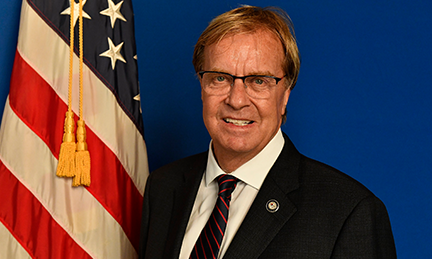
Can you describe the top skills or values you learned during your time in 4-H?
KT: There were five children in our family. We experienced the loss of our brother when he was 17, and honestly, 4-H prepared us to be able to deal with something like that. I can credit not only my parents, but also the leadership responsibility learned in 4-H. We also learned how to value others first, so we knew how to deal with a very dire situation like losing our brother. I think it was 4-H that taught us to care for other people and put other people first, ahead of our own interests. That helped us deal with the tragedy we went through in our family.
4-H also taught us how to be more engaged and take on more leadership roles in school and other activities. I would almost imagine that 80% of our community was involved in 4-H in some way. It made it a very dynamic community, which fostered many leaders who went on to contribute value today and into the future.
How did those skills lead you to where you are today, both personally and professionally?
KT: I believe that my growth in business was the result of my experience in 4-H. No matter what activity we participated in, there was a business element. I had some projects as a senior in high school that allowed me to make more than some of my teachers at school. It was the foundation of a 4-H experience—which started at 5 or 6 years of age—that gave me the footing to grow a business today. Now, that business has grown to have agriculture operations in Indiana and Argentina, as well as investments in ag start-ups in San Francisco.
Please share your thoughts on the evolution of 4-H and how you think the organization is preparing today’s young people to be leaders in their communities.
KT: I think that evolution has been in place for some time as we’ve seen 4-H evolve and expand, offering opportunities for more young people in rural and urban communities. Let’s face it, we’ve had a lot of growth in urban areas as far as population goes, and we’ve seen rural populations decline. So the trend has been pretty well paralleled. When I served as a Trustee for National 4‑H Council, I learned about projects that represent that evolution. We visited an aquaculture farm that a group of 4-H’ers was running in downtown New York. That was exciting for me! In the rural areas we visited, I’ve seen a protein packing plant. These 4-H’ers are contributing and building a successful future. They give back to the community, and at the same time, they improve their own economic future while helping others to do the same.
Well before accepting your current role as U.S. Ambassador to the UN Agencies in Rome, you played a significant role in agribusiness and economics, from serving on international boards to overseeing production at Tom Farms. Tell me about the defining moment in your career in agriculture in which foreign affairs became a key focus?
KT: Throughout my career, I’ve been on several boards and involved in philanthropic efforts, trying to assess why we have so many people hungry around the world when agricultural productivity is so high in the United States. I got involved with an organization called Farmers Feeding the World, and along that way, I met Howard Buffett. Together, we visited Afghanistan and Iraq, where we witnessed firsthand how people are struggling to feed themselves. At the same time, one of my fondest memories is as a member of National 4-H Council’s Board of Trustees. We went to Kenya and Tanzania, where we saw some of the 4-H clubs operating down there. While in Kenya, we met Millicent Obare, principal of Nyaminia Primary School. I think she had nearly 900 students at the school, and those kids were so excited about their 4-H experience. They were eager to learn how to grow a livelihood and at the same time give back to the community. All of this set the stage for where I am today.
You have often spoken out about the crisis on hunger that is plaguing countries around the world, once saying, “too many people go to bed hungry…and our world pays the consequences because of that.” Tell me about some of your work to date on combatting this issue and how can young people help support the mission to end world hunger.
KT: The Food and Agriculture Organization recently released its SOFI 2019 report, The State of Food Security and Nutrition in the World, which cited that the number of people who are chronically malnourished and on the edge of starvation and famine grew from 810 million a year ago to 827 million this year. Those numbers continue to increase, with no anticipated change in the near future. It’s very concerning. So, in the role I’m in today, I represent the U.S. out of Rome and the way we work with the World Food Program (WFP), the International Fund for Agricultural Development (IFAD), and the Food and Agriculture Organization (FAO). These UN Agencies go out and work with those who have the immediate need and are facing hunger. Human conflicts drive hunger in many of these places, and we sometimes find out much of this conflict is driven by not having access to food, and people migrate, and we have long, drawn out, damaging conflicts. And then we have an even greater crisis in feeding people. I work a lot with the FAO, an organization with a mandate to go out and create resilience and capacity in food systems to feed people. It’s a big mission, one with a broad mandate, and it’s essential. I can tell you, I didn’t leave five children, 11 grandchildren, and two 90-year-old parents to come here and not get anything accomplished. I’m here to get work done.
What are some ways 4-H and other youth organizations can keep youth more informed about these topics?
KT: I think we need to talk about it in 4-H clubs. We can talk about just how great the need is on a global scale. Think about it this way. Africa will double its population by 2050. How are we going to feed them? We can barely feed them today. I think that puts it in a clear perspective of just how great that need is. The capacity is going to be needed to feed the world. The demand for food is going to continue to grow, and there are so many places for young people to be involved. Along with agriculture, STEM programs allow us to innovate and think about new ways to feed a hungry world.
What message would you share with young people to encourage them to want to help feed their community and world?
KT: Realize that we don’t live in a static world. We need to understand our past, but we also need to look to the future. Realize that there will be so many careers available and jobs created in the next ten years. Have an open mind. Understand the global perspective, because as we continue to live in a more global society, there’s a need for youth to be very adept at changing. Be very aware of those around the world. Be very broad in your academic choices as you go through high school or college. Make sure you leave yourself open to dream a little bit. Our access to technology does not limit our ability to innovate. It’s only limited by our ability to dream.
Lastly, I leave you with this final statement: “I am only one, but I am one. I can’t do everything, but I can do something. And something I ought to do.” My father repeated it to me many times as a child, and that’s why I remember it. I use that as a challenge to young people as they look at the complexity of the world today and how it may seem too big of an obstacle to overcome. It’s a statement that’s very close to my heart, and I challenge everybody to get involved and be a part of the solution.
For over 100 years, 4-H has inspired families, shaped careers, and impacted communities. On October 6 through 12, we will celebrate the impact of 4-H during National 4-H Week. Here are some ways you can celebrate 4-H!
With permission, host a 4-H rally at a school or community center. It’s a great way to bring the community together to celebrate and show the pride of your local 4-H program
Local programs are always looking for resources to continue growing the programs. Help programs like the Flying Squirrels or Green Turtles (not real clubs, by maybe) thrive by making a donation that can help provide supplies to kids in the area.
Nothing says 4-H pride like a 4-H tee! Dress yourself (or the entire family – pets included!) in 4-H green and 4-H gear, available at Shop 4-H.
If your local grocery or hardware store allows, set up a table to share information about your local 4-H program. You can display 4-H posters, hand out flyers, or showcase the work of local 4-H’ers.
Kids love 4-H. They enjoy the time they spend with 4-H friends, look forward to their next 4-H meeting, and plan all year to show off what they’ve learned. Recognize the hard work and dedication of 4-H’ers by shouting out one or an entire club on social media.
In some communities, you can ask local businesses to display 4-H posters. Many may be willing to dedicate their entire storefront to 4-H signs, memorabilia, and décor for the week.
If you are a 4-H alum, you might be looking for ways to reconnect with 4-H. Consider giving your time to a local 4-H club by becoming a volunteer.
Take to social media to share a 4-H memory, express how 4-H shaped who you are today, describe what 4-H means to you, post an old 4-H photo, or shout-out your 4-H club. Use and follow the hashtag #InspireKidstoDo, share your story, or read stories similar to yours.
4-H alumni often credit 4-H for the connections they’ve made, remembering the friends they made and those who they may still keep in touch with today. Gather your old 4-H friends and spend some time together reminiscing on your 4-H experience or recreate your 4-H project together!
We all have a reason to thank our local 4-H leaders. Whether you grew up in 4-H, you have kids in 4-H, or you’ve witnessed the positive work of 4-H in your community, send a ‘thank you’ note to your local Extension/4-H office to show your appreciation,

Today, Lisa is a member of the State Line Tack marketing team where she uses her equine industry knowledge to help State Line Tack connect with organizations who also want to support the equine community through experiences and education. National 4‑H Council is the newest organization to partner with State Line Tack, inspiring kids to jump to new heights through the partnership.
While there’s a clear connection between 4‑H and State Line Tack, Lisa connects with 4‑H on a more personal level.
She is a 4‑H Alumna.
Lisa’s parents immigrated to the United States from Denmark in the mid 1950s. In 1969, at the age of 8, Lisa was introduced to 4‑H. As her 4‑H experience began in Bellevue, Washington, she discovered what she truly loved – horses.
“[My mom] realized that 4‑H was a very American thing,” Lisa explained. “And 4‑H to her was the equivalent of what your child can do from start to finish.”
Like her mother, who grew up on a dairy farm, Lisa also understood the importance of valuing all animals, thanks in part to 4‑H. Because of the values learned in 4‑H, her mother spent what Lisa describes as “thousands and thousands of hours” driving her back and forth to 4‑H club meetings, events, and shows.
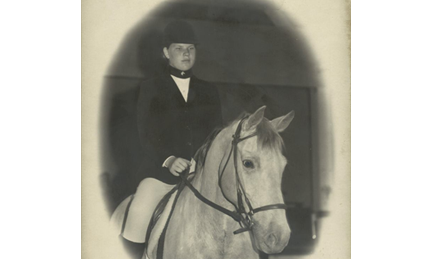
“We learned to rely on each other,” she recalls. “Even though we competed against each other, we rooted for each other, and we were always friends at the end.”
When remembering the friends she made, the skills she learned, and the opportunities she was fortunate enough to have, she stresses that those experiences would not have been possible without family.
“Without our parents, our family members, or whoever it is that’s taking us everywhere, it wouldn’t happen. I think we really need to acknowledge the fact that they helped us,” she says.
Because of the help she received, plus her 4‑H experience, Lisa went on to study International Business at Washington State University, traveled the world, and today, helps State Line Tack become a leader in equine supplies and education for all ages in all communities.
Through the 4‑H and State Line Tack partnership, Lisa hopes to create a local impact and help raise more awareness of 4‑H programs in communities where 4‑H may not be prevalent. Additionally, she wants more kids to experience what 4‑H has to offer, whether through equine programs, other livestock learning, and more.
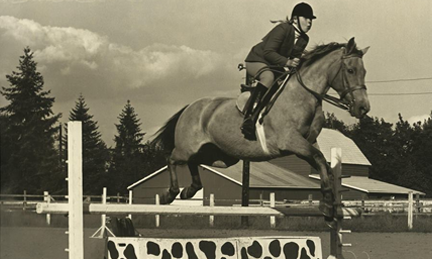
Lisa credits 4‑H with teaching her so many of the valuable professional skills she still uses today including organization, presentations and time management. On a personal level, Lisa raises and shows Shetland ponies, and her first homebred world champion is now being well cared for and loved by a young 4‑H’er in Indiana.
State Line Tack is a proud supporter of 4‑H’ers across America. National partners like State Line Tack help fund local equine programs and support National 4‑H Council’s mission to grow 4‑H from 6 million to 10 million kids across the country. Learn more about our partnership.
DH: 4‑H was very instrumental in molding me into who I am today. My interest in many things started at home; however, 4‑H was where I learned more, and it helped me build my confidence to participate in the many projects. It helped me build the confidence to become a leader, first by participating at the local level, then to participate at the state level. 4‑H helped me to find what my interests were and to grow those interests. It helped me become who I am today. I can say that without 4‑H, I never would have had the confidence to speak before a group. It was the start of a passion I have today, and that is to educate youth and adults about how their food is grown.
Are you still involved with 4‑H now?
DH: I am still involved with 4‑H today. I don’t know if there was a time that I wasn’t involved in 4‑H in some form. I was heavily involved while my children were growing up through 4‑H. Later, assisted the 4‑H agents whenever they needed help after they graduated because my youngest never stopped working with 4‑H’ers either. I then formed a non-profit, the Fast Food Farm, where I work with 4‑H’ers and FFA students. The goals of the Fast Food Farm are: to educate consumers of all ages about how their food is grown; create innovative educational materials to which teachers and students can relate; teach the importance of agriculture to our daily lives and to the economy; provide mentoring opportunities for all students; and provide leadership opportunities for 4‑H, FFA, and Pro-Start students. The students are trained to be peer teachers for the two large events we have at the farm each year. I serve on the St. James Parish 4‑H Foundation Board, as well as the Louisiana 4‑H Foundation Board.
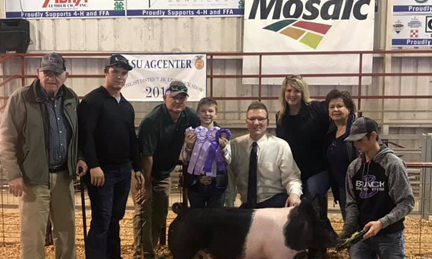
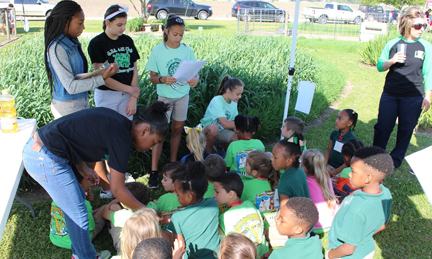
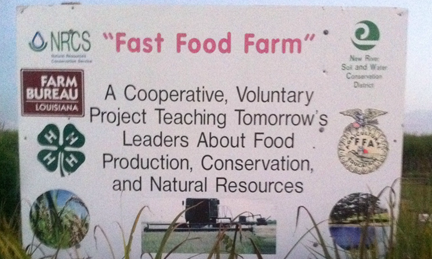
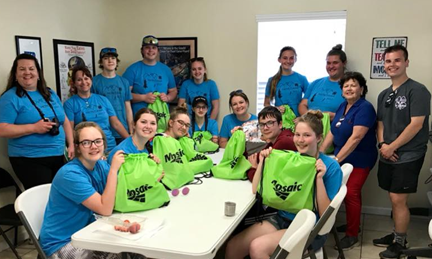
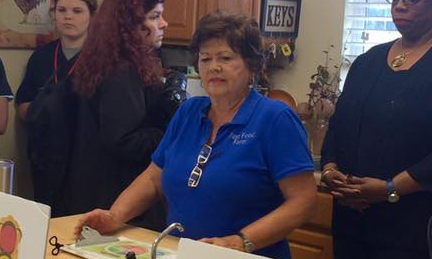
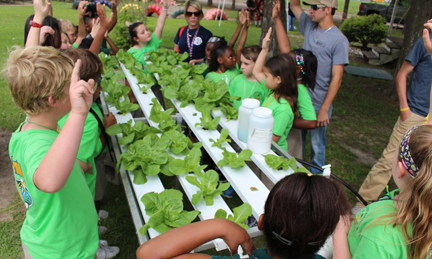
I wouldn’t be who I am today without 4‑H. Growing up, I was a very shy young person. I wouldn’t ever dream about speaking to new people or in front of a crowd (unless it was a nightmare) until I joined 4‑H. I had an amazing 4‑H agent who encouraged me to join the horseless horse club to learn more about horses. The club also helped me work through my fear of horses due to a traumatic experience when I was a young child. I loved it so much, and it eventually helped me work through my fears and start riding horses again. That then started my mom to become a local 4‑H Horse leader for our valley. I was able to be a leader and start learning how to run meetings and encourage the younger members to be involved and engaged. I loved working with youth and agents from across the state, which helped me network and has helped me throughout my career. I also loved working with the younger kids in a camp setting, which cemented that I knew I wanted to work with youth no matter what in my future careers. The life lessons learned in 4‑H have helped in my life, and I love being able to pass on those life skills to my children. I am so thankful for the many opportunities and doors it opened up for me.
Like many of my peers, agriculture is in my blood, and 4‑H was the first organized outlet to meet others with similar interests and begin sharpening my skills. I have fond memories of Red Ranger club meetings where the adults truly let us become leaders and run a meeting. It also provided unique outings and taught me how to speak in front of a group through demonstrations. It was also something we did as a family. Meetings took place in our basement, and we worked together to finish projects, prep pigs for the show ring, and traveled 2.5 hours to the state fair to present award-winning rice crispy treats. 4‑H offered an outlet to express yourself through any interest. Today, I try to be a spokesman for agriculture at all levels. I remember some of my first experiences with the media were being at the Fair representing 4‑H. As an adult, I have been asked to do national media interviews and work directly with consumers and legislators.
I was raised in a very rural community. Growing up, 4‑H provided me opportunities to meet people outside of my community and experience different cultures. I also participated in leadership, citizenship, and community service activities that taught me the values of ethics, fairness, hard work, and commitment. My fair animal projects helped me save money to pay for my college education and establish a partnership with my dad buying and selling feeder cattle. Many of my memories growing up involve some type of 4‑H activity. I owe many of the skills that I have today to my time in 4‑H. As a nurse practitioner, I have to be able to multitask, think critically, and make strong decisions, sometimes very quickly, while having compassion, good listening skills, organization, and documentation skills. As a member of several director’s boards, I use meeting organization skills, parliamentary procedure, group organization, leadership, and strategic planning. After researching farm safety and injury prevention when I obtained my doctorate in graduate school, I am now a farm safety expert and I travel locally and nationally speaking on this topic. I am still involved in 4‑H today. I volunteer as a 4‑H leader in my local area, was an adult leader at 4‑H camp, served as a judge for district contests, served as a club leader for the Cloverbud Club, and assisted with special interest programs at the local level. I am a past president of the State 4‑H Leaders Association and remain on the state Board of Directors as the Central District President.
“Bob Baffert is a fellow 4-H’er. We both grew up in 4-H,” Nettles shared. “So I’m definitely going to be betting for some of his horses for sure.”
And yes, two-time Triple Crown winner Bob Baffert had three horse in the race. While he was hoping to secure the historical title of three-time Triple Crown winner, his horses, Game Winner, Roadster, and Improbable, placed 4th, 5th and 15th, respectively.
In March, Bob Baffert attended the 10th annual 4-H Legacy Awards, where he received the Distinguished 4-H Alumni Medallion. Before accepting the award, he shared how 4-H prepared him to become the successful horse trainer he is today.
“I learned to communicate with these animals, and [4-H] really helped me through the years,” he said. “So it really helped me down the road to pick horses out, which turned out to win Kentucky Derbies.”
In honor of the 10th Anniversary 4-H Legacy Awards, we are excited to share our favorite 4-H Legacy Awards moments through the years. We look forward to creating many more special memories in the years to come!
At just 12 years old, Callista Clark demonstrated the skills and courage she learned in 4-H by performing a duet with Grammy Award winner, singer and songwriter (and 4-H alum) Jennifer Nettles at the 2016 Legacy Awards. Both the Georgia natives began their careers in the 4-H & Company performing arts group, which has launched the careers of many renowned performers.

The 2010 4-H Youth in Action Award, the first of its kind, was presented to 4-H’er Samantha Jo Ridley, a member of the Standing Rock Sioux Tribe in North Dakota, who was the first in her tribe to attend college. Through 4-H, Ridley has helped her community in many ways, including using her involvement in archery to bring the tradition back to her tribe. Ridley went on to earn a B.S. in Biology, and is currently working towards achieving her dream of becoming a neuroscientist.
Jennifer Nettles, the 2012 Distinguished Alumni Medallion winner, credits 4-H with providing her with invaluable life skills as well as performing skills, which she still uses to this day. Thanks to the depth of diversity in 4-H, as well as the vast amount of choices available to young 4-H’ers, Nettles believes that the “sky’s the limit!”
Carla Hall, a renowned chef, ‘The Chew’ co-host and author, reprises her role as emcee of the Legacy Awards this year, having made a great impression in 2012 at the 3rd Annual 4-H Legacy Awards in New York.
All of our previous Youth in Action award winners have made a substantial impact on their communities, whether it’s in STEM (Cassandra Ivie), Civic Engagement (Amelia Day, Elisabeth Willis, Samantha Jo Ridley), Healthy Living (Nosa Akol, Andres Parra, Morgan Billingslea-Walker) or Agriculture (Nate Seese).
These incredible young people credit 4-H with giving them the opportunity and skills to go out into their communities and make a meaningful difference in the lives of those around them.
One such winner was Ru Ekanayake, who was honored as the 2016 Youth in Action Award Winner, thanks to her passion for Healthy Living.
Dr. Faustino “Tino” Bernadett began his working life selling eggs door to door from his red wagon in Chico, California, before going on to become a leader in both the practice and business of medicine. In an effort to reduce disparities in access to education and health, Bernadett co-founded the Molina Foundation in 2004, which partners with 4-H and Cooperative Extension to distribute millions of free books to children around the country.
Aubrey Plaza is an award-winning actress and producer, who proudly pays forward what she learned in 4-H. As the 4-H Service Ambassador, Plaza encourages young people to get involved and give back to their communities. For her part, Plaza works with the Wilmington Drama League to promote community theater and arts programs in Delaware, and as evidenced in an interview with Stephen Colbert, she can still recite the pledge from heart!
Craig Melvin is an award-winning journalist, national correspondent and South Carolina 4-H alum, who currently co-anchors The Today Show on NBC. Melvin was involved in several 4-H public speaking programs as a middle schooler, but it was a 4-H television project in which he covered an election night that led him to his chosen career path. Melvin also credits 4-H with teaching him compassion and empathy, which he demonstrated to good effect in his Day in the Life video with John Gabalski, a 15-year old New York 4-H’er.
From Samyra Miller’s stirring acapella rendition of the National Anthem to the 4-H and Company performance with Jennifer Nettles of her hit song, Stand Up, our talented young 4-H’ers have provided us with many inspiring moments over the years.
A New Orleans native, Samyra Miller was President of her high school 4-H club, a junior leader in her parish and President of the Louisiana 4-H State Performing Arts Board. In her spare time, Miller was also the first girl to play on her school’s varsity football team.
The Legacy Awards wouldn’t be the same without our extraordinary 4-H alumni. A select few are not only honored with Alumni Medallion Awards and inducted into the 4-H Luminaries each year, but also emcee the evening, perform, act as auctioneers and host the green carpet.
Previous Alumni Medallion Award winners have included Zippy Duvall, President of the American Farm Bureau Federation, and the Atlanta Hawks’ Kent Bazemore. Distinguished alumni have included Facebook Executive Andrew Bosworth and Jill Soltau, CEO of JCPenney, who have been welcomed as 4‑H Luminaries.
Emcees have included top chefs Lazarus Lynch, Anne Burrell and Carla Hall; the VP of Public Affairs for UPS, Nikki Clifton; legal commentator and TV journalist, Nancy Grace; and award-winning journalist and author, Nancy Redd.
If you’re ready to help us continue to support exceptional youth across the nation, consider donating $10 in honor of the 10th Anniversary 4‑H Legacy Awards! Your support will help kids learn by doing, grow from failure and develop the skills they need to handle what life throws their way.
As I look back on my 4‑H career, there are certain events that stand out as being particularly impactful, and National 4‑H Conference was one of them. In honor of the 2018 National 4‑H Conference happening this week, I would like to share about my own National Conference experience. I was selected for the 2012 Georgia delegation to attend National 4‑H Conference through a competitive interview process. I flew to Washington, D.C., that April with the rest of the Georgia delegation for a week filled with learning, fun and experiences that created lasting memories.
Part of the time at Conference was spent touring Washington, D.C., meeting with legislators at the Capitol, and hearing from keynote speakers such as former Second Lady Jill Biden and former United States Agriculture Secretary Tom Vilsack at the National 4‑H Conference Center. However, the majority of the time was spent working in roundtable groups that partnered with federal agencies about current topics that were affecting youth nationwide. The topics for that year included alcohol and drug use prevention, equal education for under-represented groups, youth suicide prevention, healthy eating and living, and integration of veteran and military families into local communities.
The roundtable that I was a part of focused on using science and technology to improve local communities. We spent our roundtable session time brainstorming solution ideas and working on our presentation that we gave at the U.S. Forest Service at the end of the week. It was such an exciting opportunity to be able to present our ideas to an actual government agency in D.C. because our proposal had the chance to make a real-world impact. We celebrated our work and the new friendships with a dinner cruise on the Potomac River to close out the week.
National 4‑H Conference was my second time visiting Washington, D.C., and the National 4‑H Center as I had attended Citizenship Washington Focus the summer before. Through these two experiences, I discovered my love for the D.C. area and decided that I someday wanted to call this place my home. Six years later, I have relocated and am working as a Digital Marketing Intern forNational 4‑H Council. I am thankful for my National 4‑H Conference and CWF experiences because they helped me discover my passions, and they played a role in getting me to where I am today.
Attending National 4‑H Conference allowed me to connect with other 4‑H’ers and leaders from across the country, explore our nation’s capital, and work with a team to develop solutions to a current issue. I have remained connected with many of the people I met that week through social media and am impressed by the things they are accomplishing in their lives today. I am excited to hear about the wonderful things that this year’s group of delegates will accomplish during their time here. I am proud to be 4‑H Grown!